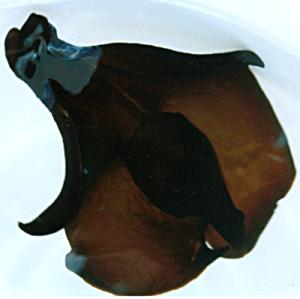
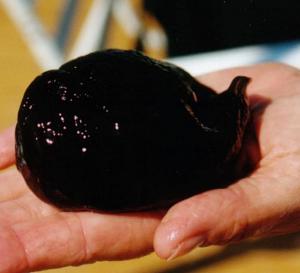
Aplysia morio
Verrill, 1901
Order: ANASPIDEA
Superfamily: APLYSIOIDEA
Family: Aplysiidae
DISTRIBUTION
Known from Bermuda and the eastern USA from Rhode Island to Florida and Texas.
PHOTO
Pompano Beach, Florida, March 2001. Photo: Anne DuPont
A large Sea Hare growing to at least 40cm long (Verrill, 1901). The parapodia are very large and are spread very widely when the animal is swimming. Colour a deep brown to black with no spots. Sometimes darker lines and stripes can be seen on the head and sides.
Reference:
• Eales, N.B. (1960) Revision of the world species of Aplysia (Gastropoda, Opisthobranchia). Bulletin of the British Museum (Natural History), Zoology, 5(10): 267-404.
Rudman, W.B., 2001 (March 8) Aplysia morio Verrill, 1901. [In] Sea Slug Forum. Australian Museum, Sydney. Available from http://www.seaslugforum.net/find/aplymori
Related messages
Sea hare - Aplysia morio in Bermuda
June 3, 2010
From: Hanna Markham
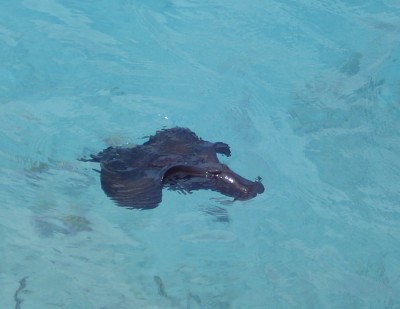
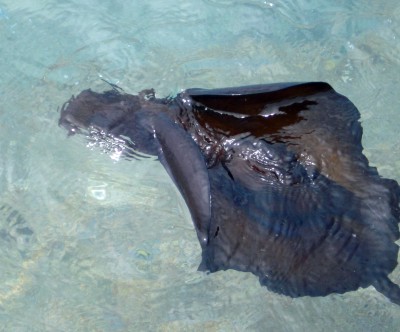
I was fishing from the rocks and this sea hare [Aplysia morio] came right across where we had our lines. I have never seen one in Bermuda before and had no idea what it was at the time.
Locality: Ferry Reach, 15 feet, St.Georges, Bermuda, Atlantic Ocean, 23 May 2010, Intertidal rocks. Length: 12 inches. Photographer: Hanna Markham.
Hanna Markham
dejager@hotmail.com
Markham, H, 2010 (Jun 3) Sea hare - Aplysia morio in Bermuda. [Message in] Sea Slug Forum. Australian Museum, Sydney. Available from http://www.seaslugforum.net/find/23690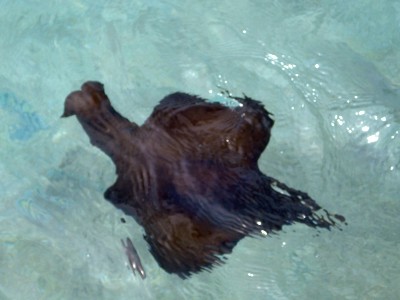
Thanks Hanna,
Bill Rudman
Re: Sea Hare found on Lovers Key beach
May 5, 2010
From: Mary and Sang Hwang
Concerning message #17084:
There is a beautiful stretch of state park beach just off Bonita Springs Road which you access either thru the main entrance to the park, which is an $8 car fee, and then by taking a tram or by parking just before the bridge and walking thru a gate and paying the $2 state park fee to park your car. This area on the west coast of Florida is called Lovers Key and is just south of Fort Myers.
My husband and I walked along the beach and ran into so many creatures that we had never, ever encountered on the east coast beaches!! We threw many sea urchins back in and giant mussels that were 20x the size you eat at a restaurant! But the most interesting was the big green blob that my husband saw and pushed w/ his foot. Just looked like slime, and it had no spots or stripes to make it look like a creature. It was a beautiful light green color, similar to a modem lite but not as neon. When I took a closer look, we saw it had "Shrek ears" starting to protrude from it's head, trademark to a land snail or slug. But I also noticed it had wrapped itself up in a ball like a bat which meant it had wings like a sting ray. Tried to balance it on two huge mussels and return it to the water's edge, and that's when the magenta ink came bursting out like a squid and turned the whole edge of the beach pink!! It was the most amazing thing! Did manage to get it tossed back into the ocean, but not sure it could survive in the whirlpool of a current right there where gulf meets bay. Biggest upset after finding your website is we never snapped a picture - we were too dumbstruck!
Locality: Lovers Key State Park beach, Ft. Myers, Florida, right where gulf meets bay, 26 April 2010, where two currents meet. Length: long blob, about 8 inches.
Mary and Sang Hwang
gallawang@yahoo.com
Hwang, M. & S., 2010 (May 5) Re: Sea Hare found on Lovers Key beach. [Message in] Sea Slug Forum. Australian Museum, Sydney. Available from http://www.seaslugforum.net/find/23590Dear Mary,
I guess you have found the General Topics List and found the list of Fact Sheets with background information on Sea Hares. One of those has a spectacular photo of an Aplysia 'inking' [see Ink Glands].
Best wishes,
Bill Rudman
Brown sea slug in the Bahamas
April 15, 2010
From: John Moore
I live in Freeport, Grand Bahama and have a house adjacent to a local canal.
My wife & I fish in the canal and 'observe' the water at night with a torch to see what is moving at night.
Last night we observed what I think was a sea slug, maybe hexibranchus, 'swimming' in the canal. It came right to the edge of the canal, I think attracted by the light of the torch.
It was choclate brown in colour, about 25 - 30 cm long with an elongated neck. I know nothing about these creatures, but the nearest I can see in your website is the Hexabranchus sanguineus - Spanish Dancer, but it did not have the bright red colouration or mottled colours and the 'wings' seemed much more regularly shaped than the pictures in the web site. We were very close, as the 'creature' swam right up to the canal side and it was just after high tide. My wife ran for a camera, but we were not quick enough and it swam off. I notices that whilst it was still breaking surface the eyes reflectre the torch light very brightly even from a long way out.
We will watch out for it and make sure we have camera to hand, but can you suggest what species it might be?
Locality: canal, surface, Freeport, Grand Bahama, Caribbean , 13 April 2010, clean concrete sided canal. tidal. Length: 25 - 30 cm
John Moore
johnandsylviamoore@hotmail.com
Moore, L. J. , 2010 (Apr 15) Brown sea slug in the Bahamas. [Message in] Sea Slug Forum. Australian Museum, Sydney. Available from http://www.seaslugforum.net/find/23490Dear John,
Although there is a species of Hexabranchus in the Caribbean - H. morsomus -, I am pretty usre you are describing a species of Sea Hare, in particular Aplysia morio. If you look at some of the earlier messages on the Forum about that species you will see quite a discussion about its swimming behaviour. Another possibility is Aplysia brasiliana which also occurs in your waters.
Best wishes,
Bill Rudman
Unknown animal - perhaps sea-slug?
April 5, 2010
From: Christoph Lehmann

Years ago I have seen an animal I cannot determine. Unfortunately I have only a snapshot of a movie film available to upload. I send a short part of the movie to your e-mail address. Many thanks in advance for your help.
Locality: Near Fort Pierce, shallow water, Florida, United States, Atlantic ocean, , 22 April 1992, in a bay near the mouth of a river.. Length: abt. 10 by 20 cm. Photographer: myself.
Christoph Lehmann
christoph.lehmann@berlin.de
Lehmann, C.G., 2010 (Apr 5) Unknown animal - perhaps sea-slug?. [Message in] Sea Slug Forum. Australian Museum, Sydney. Available from http://www.seaslugforum.net/find/23437Dear Christoph,
This is almost certainly a swimming Sea Hare and the most likely species is Aplysia morio. Have a look at the Fact Sheet and the messages attached to it for further information.
Best wishes,
Bill Rudman
Re: Swimming Aplysia in Florida
March 30, 2010
From: Maxine Gomez
Concerning message #12308:
We are in the Hillsboro inlet and keep the green lights off of the dock int he water. This evening we saw about 45 sea hares swimming around the lights. Don't know if it is of interest, but they looked so graceful we took pictures and thought I'd share the experience.
If interested I will send the pictures
Locality: Pompano, 12ft, Florida, Atlantic, March 28, 2010, At the dock. Length: 12in. Photographer: Maxine.
Maxine Gomez
gomez.maxine@swipes.com
Gomez, M., 2010 (Mar 30) Re: Swimming Aplysia in Florida. [Message in] Sea Slug Forum. Australian Museum, Sydney. Available from http://www.seaslugforum.net/find/23410Dear Max,
Thanks for letting us know. A couple of photos would be nice
Best wishes,
Bill Rudman
Re: Sea Hare in the surf - NW Florida
September 5, 2008
From: Randy Hill
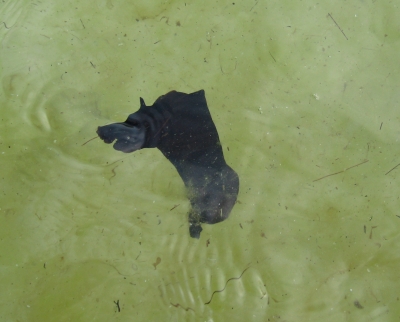
Concerning message #21657:
Just a photo of brown-winged sea slug off the beach of Seagrove, NW Florida. 31 August 2008.
There have been hundreds washed up on the beach.
Thought you would like the photo.
Randy
randy.hill@siemens.com
Hill, R., 2008 (Sep 5) Re: Sea Hare in the surf - NW Florida. [Message in] Sea Slug Forum. Australian Museum, Sydney. Available from http://www.seaslugforum.net/find/21865Thanks Randy,
From earlier messages, it looks like this species, Aplysia morio, can be found in Florida most months of the year.
Best wishes,
Bill Rudman
Re: Sea Hare in the surf - Florida
July 1, 2008
From: Laura Nugent
Concerning message #21556:
There are hundreds of them washed up on Hutchinson Island, Florida this morning and teeming in the water. There was a storm last night. I assume it is because of that. It is quite startling and sad. I lived here from 1968-81 and never saw this happen before.
Locality: Hutchinson Island, on shore and in the surf, Florida, USA, Atlantic, 23 June2008, on shore. Length: 3 -6 inches.
Laura Nugent.
sallyatticum@gmail.com
Nugent, L., 2008 (Jul 1) Re: Sea Hare in the surf - Florida. [Message in] Sea Slug Forum. Australian Museum, Sydney. Available from http://www.seaslugforum.net/find/21657Dear Laura,
As you will see from earlier messages about Aplysia morio and A. brasiliana, this is a fairly natural phenomenon - that is not to say that it is not upsetting to see. See also the Mass Mortality page.
Best wishes,
Bill Rudman
Re: Sea Hare in the surf - Florida
May 2, 2008
From: Marc Podis
Concerning message #21388:
I was diving on Sombrero reef off Marathon, Florida, April 19th and saw one of these critters swimming by 3-4 feet under the surface in about 30 feet of water. One word- majestic.
Locality: Florida keys, 3-4 feet, Florida, Atlantic, 19 April 2008, offshore reef. Length: 10 inches
Marc Podis
mp1960@comcast.net
Podis, M., 2008 (May 2) Re: Sea Hare in the surf - Florida. [Message in] Sea Slug Forum. Australian Museum, Sydney. Available from http://www.seaslugforum.net/find/21556Re: Sea Hare in the surf - Florida
February 22, 2008
From: Paul Castronovo
Concerning message #20545:
I just found 2 of these swimming under the lights under my dock in Lighthouse Point Florida, a mile north or so of Pompano Beach, Florida where many sightings have occured in the past. I have lived near, fished and dove these waters since 1971, and this is the first time I've ever seen this magnificent creature!
Locality: Lighthouse Point, 5 ft, Florida, Atlantic ocean, inland canal, 19 February 2008, swimming under dock in relatively clear canal water. Length: 8 inches
Paul Castronovo
Paul and Young Ron show
www.paulandyoungron.com
paul@paulandyoungron.com
Castronovo, Paul, 2008 (Feb 22) Re: Sea Hare in the surf - Florida. [Message in] Sea Slug Forum. Australian Museum, Sydney. Available from http://www.seaslugforum.net/find/21388Re: Sea Hare in the surf - Florida
August 27, 2007
From: Michele Mannion
Concerning message #17153:
I was just looking up these creatures because I seen several of them on the shore of Hutchinson Island in Jensen Beach, FL. There were many of them in the ocean and several on the beach, washed up. The ones washed up that were still alive, I put back into the ocean. I have lived in South Florida for 6 years now, have been coming here for 20 years, and that was the first time I seen them. I am glad to see they are not poisonous or toxic in any way.
Locality: Jensen Beach, on surface, swimming, Florida, Atlantic Ocean, 8/19/07, Dirty ocean water kicked up from storms out east.. Length: 6 inches
Michele Mannion
Taffi4379@yahoo.com
Mannion, M., 2007 (Aug 27) Re: Sea Hare in the surf - Florida. [Message in] Sea Slug Forum. Australian Museum, Sydney. Available from http://www.seaslugforum.net/find/20545Aplysia morio from Isla Cubagua, Venezuela
July 24, 2007
From: Sylvia Grüne
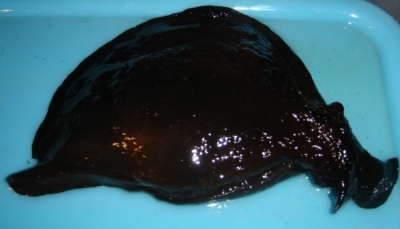
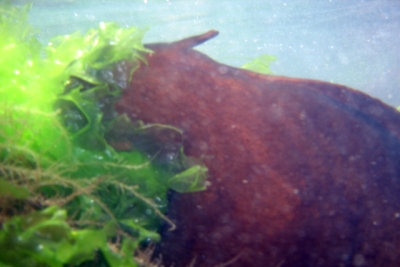
Hi Bill,
We found Aplysia morio on Margarita island at three different localities and on Cubagua Island. I have never seen this Aplysia before and it was a really amazing discovery. I collected three specimens and they are at the Museo Oceanológico Hermano Bengigno Román (Fundación La Salle), Punta de Piedras, Margarita island. The specimens were really large (aprox.40 cm)and I found them just swimming and eating Ulva.
Locality: Isla de Margarita, Isla Cubagua, surface, Nueva Esparta, Caribbean, April 2007. Length: 400 mm. Photographer: Sylvia Grüne.
Best wishes,
Sylvia
sylviagrune@gmail.com
Grüne, S., 2007 (Jul 24) Aplysia morio from Isla Cubagua, Venezuela. [Message in] Sea Slug Forum. Australian Museum, Sydney. Available from http://www.seaslugforum.net/find/20242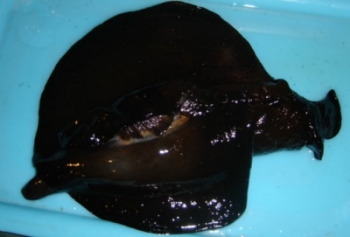
Thanks Sylvia,
Bill Rudman
Rudman, W.B., 2007 (Jul 24). Comment on Aplysia morio from Isla Cubagua, Venezuela by Sylvia Grüne. [Message in] Sea Slug Forum. Australian Museum, Sydney. Available from http://www.seaslugforum.net/find/20242Re: 'sea-bat' from southwestern France
May 2, 2007
From: Jeff Hines
Concerning message #7481:
I saw one exactly like this off a dock on the south side of Key West.
Locality: Key West, 8 feet, Florida, USA. Atlantic, 21 April 2007. Length: 10-12 inches
Jeff Hines
jhines@hinesdev.com
Hines, J., 2007 (May 2) Re: 'sea-bat' from southwestern France. [Message in] Sea Slug Forum. Australian Museum, Sydney. Available from http://www.seaslugforum.net/find/19846Dear Jeff,
If your animal was dark brown I suspect it was Aplysia morio. Have a look at the species Fact Sheet and at the messages attached to that page for more information
Best wishes,
Bill Rudman
cc Is this a variety of sea slug?
March 27, 2007
From: Molly Hogan
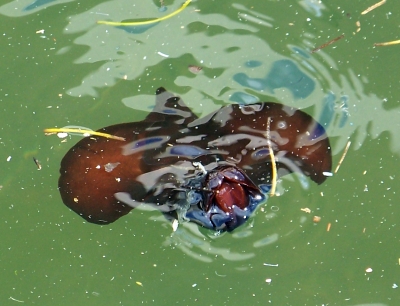
On 23 March 2007, we observed the following creature, approximately 8 inches long?, in a marina off of the Intracoastal Waterway in southern Florida (Pompano Beach). We were entranced by the flowing movement of the creature as it swam along the surface. We have attempted to identify it without success. Several people have suggested that it might be a variety of sea slug, however, we have not been able to locate a similar photo on an internet search. We'd appreciate any information.
Locality: Intracoastal Waterway, swimming at surface, Florida, USA, Intracoastal waterway, 23 March 2007, Intertidal. Length: 8 in.. Photographer: Molly Hogan.
Thanks!
Molly Hogan
hogan@lincoln.midcoast.com
Hogan, M.B., 2007 (Mar 27) cc Is this a variety of sea slug?. [Message in] Sea Slug Forum. Australian Museum, Sydney. Available from http://www.seaslugforum.net/find/19764Dear Molly,
This is a type of sea slug known as a Sea Hare. It is probably as species called Aplysia morio which is known from Bermuda and the eastern USA from Rhode Island to Florida and Texas. If you look at other messages on this page you will see it is a swimmer, and is quite commonly found in Florida. Another swimming species, Aplysia brasiliana, is also quite common in Florida. For more information on Sea Hares go to the Sea Hare Fact Sheet which has links to other pages with more information. Also, have a look at the earlier messages on this page.
Best wishes,
Bill Rudman
Sea Hare in the surf - Florida
July 18, 2006
From: Noah Steed
Concerning message #17084:
I'd like to report that we spotted this species, Aplysia morio, swimming in the surf at Panama City Beach, Florida -- at least one specimen every day July 8th through July 12th 2006. The sizes ranged from 3 to 4 inches. What's the explanation for the firmness of the bulbous part in the back. We thought it was a cuttlefish because it inked and we could feel something solid inside. Everyone had fun playing with them. They're not harmed by light handling I hope. I'd never seen them before and wonder if the fact that they were in the surf means they were dying. There'd been no heavy weather to wash them up.
Locality: Panama City Beach, 3 to 8 feet, Florida, USA, Gulf of Mexico, 12 July 2006, Surf Zone. Length: 3 to 4 inches
Noah Steed
noah@netmav.com
Steed, N., 2006 (Jul 18) Sea Hare in the surf - Florida. [Message in] Sea Slug Forum. Australian Museum, Sydney. Available from http://www.seaslugforum.net/find/17153Dear Noah,
The firmness you felt was indeed a shell, but unlike the 'shell' of a cuttlefish, which is a flotation device made up of many thin calcified layers, the shell of a Sea Hare is a single thin layer almost totally lacking in calcium carbonate. If you go to the General Topics list you will find a whole section on Sea Hares with lots of background information. In particular have a look at the Shell in Sea Hares page and the Sea Hare mantle cavity page.
If your sea hares were in the surf zone it is possible they were dying. I suspect that once they get into moving and churned up water they don't have the strength to swim or crawl out of it.
Best wishes,
Bill Rudman
Re: Sea Hare found 1/2 mile off Sth Florida
July 10, 2006
From: Daniel Bell
Concerning message #16777:
I found one of these floating/swimming beside me at Miramar Beach, Florida (near Destin). We found it on July 6, 2006. We scooped it up and looked at in a bucket for good 30 mins. It was a rather curious sight for many of us at the beach. Thank you Mr. Rudman for helping us to learn about this creature. I have been here many times and have never seen it until yesterday.
Locality: Miramar Beach, 4 Feet, Florida, USA, Gulf of Mexico, 06 July 2006, Clear with very little seaweed floating.. Length: 4 inches
Daniel Bell
danielbellcc@gmail.com
Bell, D., 2006 (Jul 10) Re: Sea Hare found 1/2 mile off Sth Florida. [Message in] Sea Slug Forum. Australian Museum, Sydney. Available from http://www.seaslugforum.net/find/17084Dear Daniel,
They are a strange sight swimming along, even if you have seen them many times before - a bit like a large flying fox or fruit bat flying overhead.
Best wishes,
Bill Rudman
Aplysia morio near St. Petersburg, Florida
June 21, 2006
From: Maria D'Oleo
Hi there:
I was walking on the beach this evening during low tide and came across five weird-looking, black, sea animals. One of them was letting out a purple ink when softly poked. I wanted to throw them back in the water and help them live, but I wasn't sure if their being at the shore was a natural occurrence of their life cycle. Most of us curious observers agreed they were some type of slug. I came home and thanks to your website now know that what I saw was the uncommon black Sea Hare Aplysia morio. After reading your site, I think the ones I saw were pretty young due to their size. I also learned the species resides mostly in the Atlantic Ocean. I have three questions: Is this type of Sea Hare common in the Gulf of Mexico as well? Tropical Storm Alberto visited our area last week. Could this hurricane have had influence on their relocation? Also, now that I know it's safe to handle them and read about mass mortality, should we help them back in the water next time if they're still alive on shore? What I saw didn't look like mass mortality. Thanks for your wonderful website! Looking forward to your answer.
Locality: Madeira Beach, at the shoreline, Florida, United States, Gulf of Mexico, 18 June 2006. Length: Sizes ranged from 15 to 25 cm long by 8 to 10 cm wide.
Maria D'Oleo
mdoleo@verizon.net
D'Oleo, M., 2006 (Jun 21) Aplysia morio near St. Petersburg, Florida. [Message in] Sea Slug Forum. Australian Museum, Sydney. Available from http://www.seaslugforum.net/find/16913Dear Maria,
Yes Aplysia morio is found in the Gulf of Mexico as well. Usually Sea Hares wash up on beaches like this after storms. They often live just off shore in sea grass and algae beds and when storm waves disturb the bottom these slugs are unable to 'hold on' and so are washed ashore. If the populations are large enough then we get 'mass mortality' events. Concerning putting them back into the sea - it certainly doesn't do any harm, but often if they wash up on a beach, throwing them back in from shore doesn't get them out of the wave zone, so within a few minutes they are washing up again. Unless you are able to return them to a 'safe' place, which may be 100 yards off shore, or a sheltered canal, it's probably best just to let nature takes its course.
Best wishes,
Bill Rudman
Sea Hare found 1/2 mile off Sth Florida
June 7, 2006
From: J Nicholas Boyd
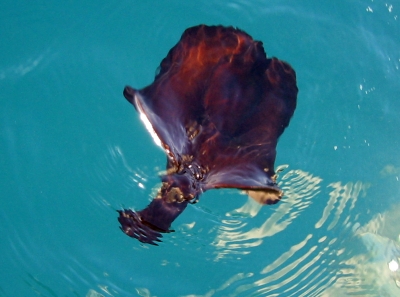
Can anyone ID this critter I came across while boating 1/2 mile off Boca Raton in the Atlantic or refer me to a site that is good for ID - I have looked and looked and coming up empty - it was very soft without bones feeling and about 14 inches and was swimming very slow but not unlike a ray swims - notice its wings which moved it along. It was on the surface - I actually scooped it up and studied it a few minutes in a bucket - wish I turned it over and taken a picture.
Locality: Boca Raton, 26 20 59.10 N 80 04 00 .03 W, 30 but on surface, Florida, USA, Atlantic, 02 Feb 2004, off shore (near a dredge site). Length: 14 inches long 10 wide. Photographer: J. Nicholas Boyd.
J. Nicholas Boyd
nboyd@oceanlandinc.com
Boyd, J. N., 2006 (Jun 7) Sea Hare found 1/2 mile off Sth Florida. [Message in] Sea Slug Forum. Australian Museum, Sydney. Available from http://www.seaslugforum.net/find/16777Dear Nick,
This is a form of sea slug called a Sea Hare. Two are quite commonly found in your part of the world, Aplysia morio and A. brasiliana. I suspect yours is the first. Both species usually crawl on the bottom feeding on various sea weeds, but at times they can be found swimming - as you say, much like a ray swims. Have a look at the Fact Sheets for those two species and the attached messages for more information.
Best wishes,
Bill Rudman
Aplysia morio in Bermuda [2]
May 22, 2006
From: Ben Hartley
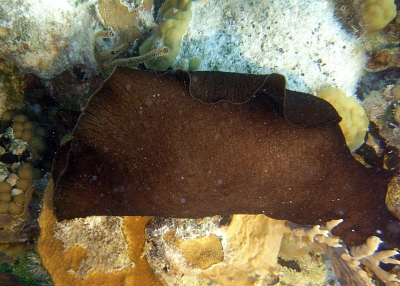
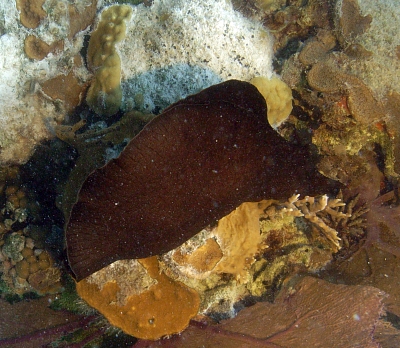
Greetings from Bermuda,
We found this guy swimming at the surface, we had seen what I believe to be the same animal the day before, but this time he just drifted up to our anchored boat and we were able to take pictures. From looking at your website I believe this to be Aplysia fasciata, but I could be wrong. If I recall correctly it is locally called a 'Sea Cat' in order to distinguish it from the much more common Sea Hare. I just thought I would just let you know that they exist in Bermuda. They do not appear to be common here, but are not unknown.
We all touched it but it at no point produced any ink that we sometimes see from sea hares, can this species produce ink like the others?
If it was indeed the same animal both times, that would mean it had traveled at least 0.98 miles (1.48 km) in approximately 24 hours.
Locality: 32.330862 N, 64.887174 W, Halfway Flat, 0 to 3 meters, Bermuda, Atlantic Ocean, Sargasso Sea, 15 May 2006, sandy bottom, reefs. Length: 35 cm . Photographer: Greg Hartley.
Ben Hartley
bhartley1024@yahoo.com
Hartley, B.B., 2006 (May 22) Aplysia morio in Bermuda [2]. [Message in] Sea Slug Forum. Australian Museum, Sydney. Available from http://www.seaslugforum.net/find/16632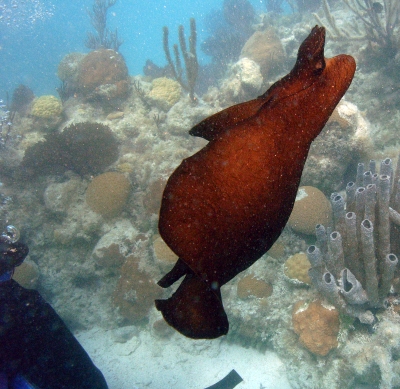
Dear Ben,
This is Aplysia morio. I am also posting a message from Thad Murdoch [message #16641] of another sighting from Bermuda. If you look at earlier messages on this species and the other swimming Caribbean species A. brasiliana you will find links to much we know about their biology. Concerning whether they produce their purple ink, have a look at message #16137 where there is a photo of one inking
Best wishes,
Bill Rudman
Aplysia morio seen in Bermuda
May 22, 2006
From: Thaddeus Murdoch
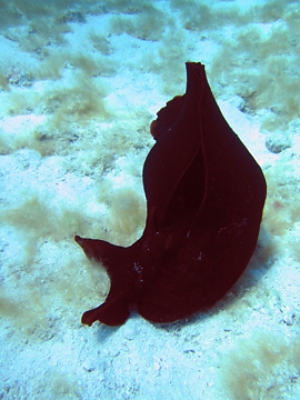
I photographed and videotaped a large (~35 cm) Aplysia morio at the "Snakepit" MPA located on the northern lagoon rim of the Bermuda platform yesterday.
The aquarists at the Bermuda Aquarium, Museum and Zoo say that we often get many this time of year, both offshore and in inshore bays, frequently under bridges. Apparently the local common name is the "Undertaker".
Locality: Island, 25 ft, Bermuda, Atlantic Ocean, 16 May 2006, Sandy area near backreef. Length: 35 cm. Photographer: Thaddeus Murdoch.
Thaddeus Murdoch
tjmurdoch@gov.bm
Murdoch, T.J.T., 2006 (May 22) Aplysia morio seen in Bermuda. [Message in] Sea Slug Forum. Australian Museum, Sydney. Available from http://www.seaslugforum.net/find/16641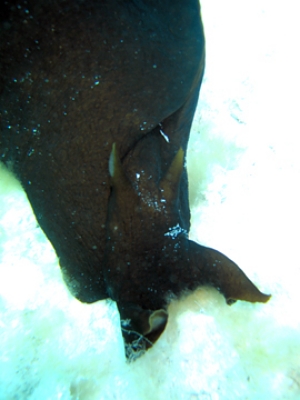
Dear Thad,
Thanks for a photo from Bermuda. All the records we have at present are from Florida. 'The Undertaker' is a colourful common name - I wonder if there is an interesting story attached to it or whether it is because of its blackish coloration.
Best wishes,
Bill Rudman
Sea slugs in Ft. Lauderdale, Florida
April 11, 2006
From: Linda Sandler
Hi..
We were at our boat dock yesterday in the Intracoastal waterway off the Atlantic Ocean in Ft. Lauderdale, FL. USA and we saw a few sea creatures that we couldn't identify. Someone said they were sea slugs. They were dark in color about 8 to 12 inches long and they had a snout and seemed to be air breathers as they kept coming up for air. Someone at the Marina said they emit an ink when they are threatened. They seemed to have ripply side wings when they swam. Can you idenify them as sea slugs? I glanced at your web site and there are so many different species of slugs and the ones I clicked on didn't look like what we saw.
Locality: Intracoastal Waterway, surface, Florida USA, Atlantic Ocean, 07 April 2006
Linda
Blunoz22@aol.com
Sandler, L., 2006 (Apr 11) Sea slugs in Ft. Lauderdale, Florida. [Message in] Sea Slug Forum. Australian Museum, Sydney. Available from http://www.seaslugforum.net/find/16285Dear Linda,
Have a look at the Fact Sheets on Aplysia morio and Aplysia brasiliana and also the messages attached to the bottom of those pages and I'll think you will find what your saw.
If you want to see all the messages on a page opened together, so you can quickly look at all the pictures, go to the bottom of the Fact Sheet, below the message list, and click on 'show factsheet and all related messages'.
Best wishes,
Bill Rudman
Re: Sea slug or hare? from Florida
April 4, 2006
From: Alicia Miloszewski
Concerning message #16137:
Hello, my children and i were in the ocean on A1A just North of commercial blvd.(Pompano Beach, Florida) We saw one of these. We followed it and took it out of the water with a stick briefly to look at it. Never saw anything like it! Wish i had a camera. It was kind of creepy looking and at first we just thought it was a piece of a hefty bag floating in the water. Wish we could of looked at it longer but a woman came by and begged us to put it back in the water so we did. What an experience to get to see a new creature that we never knew existed.We did no harm to the creature.
Locality: Pompano Beach, On the shore line in the shallow water, Florida, USA, Atlantic Ocean, April 1st (not a joke), a lot of seaweed in the water, more than usual. Length: 8 to 10 inches long and maybe 5 wide.
Alicia Miloszewski
dragonfly65@bellsouth.net
Miloszewski, A., 2006 (Apr 4) Re: Sea slug or hare? from Florida. [Message in] Sea Slug Forum. Australian Museum, Sydney. Available from http://www.seaslugforum.net/find/16227Sea Hare sighting -Florida
March 23, 2006
From: Mike Jackson
Re: message #16137
Saw one of these off of Singer Island and I wondering 'WHAT THE HELL IS THAT?!?" Thanks for posting so now I don't have to call the CDC [Center for Disease Control] or SETI [Search for Extraterrestrial Intelligence]...
Locality: Singer Island, 10 feet, FL, USA, Atlantic, 19 March 2006, Beach, coastal, reef. Length: 10 inches.
Thanks again,
M -
michael.jackson@lmco.com
Jackson, M., 2006 (Mar 23) Sea Hare sighting -Florida. [Message in] Sea Slug Forum. Australian Museum, Sydney. Available from http://www.seaslugforum.net/find/16152Lots of Sea Slugs - Florida
March 23, 2006
From: Jonathan Lucco
While at the beach today with the family I saw well over 30 Sea Slugs in about 20 minutes. There was a large dredge just off shore and the sea slugs where going out with the tide. The tide just ebbed and was going out hard
I was a charter capt for many years and spend a lot of time on the ocean but only one before today.
What are their predators and what do they eat?
Locality: Boca Raton, Florida, 19, March 2006, out going tide, dredged offshore. Length: various
Jonathan Lucco
muraleye@bellsouth.net
Lucco, J., 2006 (Mar 23) Lots of Sea Slugs - Florida. [Message in] Sea Slug Forum. Australian Museum, Sydney. Available from http://www.seaslugforum.net/find/16138Dear Jon,
Sounds like you found some Sea Hares. From the recent messages we have from Florida its most likely the animal you saw was Aplysia morio. If you look at recent message attached below yours on this page you will see some photos and further information
Best wishes,
Bill Rudman
Sea slug or hare? from Florida
March 22, 2006
From: Brenda Stimely
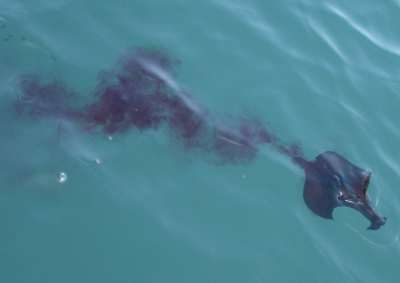
We observed this dark brown/black sea slug of sorts near the shore line in the rocks and swimming freely across the surface of the lagoon. It appeared to swim similar to the "breast stoke." As it waved it's "wings", it's head would bob up and down breaking the surface of the water as if breathing with each stroke. When touched it would release a dark purple ink.
Locality: Peanut Island, West Palm Beach, on or near surface, Florida, United States, Atlantic Ocean inlet, 17 March 2006, Man-made reef/lagoon . Length: approximately 8 inches. Photographer: Brenda Stimely.
Brenda Stimely
brendon8@bellsouth.net
Stimely, B, 2006 (Mar 22) Sea slug or hare? from Florida. [Message in] Sea Slug Forum. Australian Museum, Sydney. Available from http://www.seaslugforum.net/find/16137
Dear Brenda,
From the dark brown colour I would suspect this is the Sea Hare Aplysia morio. Another common swimming one in your part of the world is Aplysia brasiliana.
It's nice to see the photo of the animal releasing its purple ink. If you are interested have a look at the Fact Sheet on Sea Hares and the page on their purple ink.
Best wishes,
Bill Rudman
Sea Hares in Florida
March 22, 2006
From: Holly Sweat
March 17 2006 Boynton Beach, Florida: Sea Hares are mass beaching
along the intercoastal directly across from the inlet. They are are releasing eggs.
Is this normal for then to beach and reproduce. We put them back in the water some do head to deep water. Yesterday 15 were on the shore today about 35. Noone where we live has seen this happen before.
Locality: Boynton Beach, Florida, Intercoastal Atlantic ocean, 17 March 2006, across from ocean inlet. Length: 5in. to 10 in.
Holly Sweat
shovelove@aol.com
Sweat, H., 2006 (Mar 22) Sea Hares in Florida. [Message in] Sea Slug Forum. Australian Museum, Sydney. Available from http://www.seaslugforum.net/find/16134Dear Holly,
It is most probable that your animal is Aplysia morio. Have a look at the Fact Sheet on that species, and the messages attached below to see other records and photos of the species. These mass aggregations are discussed there and also on the Mass Mortality page. It is also possible your species is Aplysia brasiliana, as both occur in Florida.
It is interesting how often regular visitors or residents of a beach have never seen sea hares do this before. Often these events happen in two or three days so are often missed even by quite regular visitors.
Best wishes,
Bill Rudman
Swimming Sea Hares in Florida
May 2, 2005
From: Nick Stone

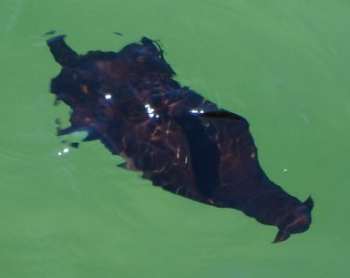
The attached pictures were taken from my dock on a canal in Pompano Beach, Florida, USA, about three weeks ago. We first spotted the creature when it was 4-5 feet below the surface, but then it swam to the surface and swam around for aboiut 10 minutes. It even stuck its head out of the water twice and seemed to be looking at us. We were glad it was only about 10 inches long, not 10 Ft.!
Nick Stone
stonejohn@bellsouth.net
Stone, N., 2005 (May 2) Swimming Sea Hares in Florida. [Message in] Sea Slug Forum. Australian Museum, Sydney. Available from http://www.seaslugforum.net/find/13698Dear Nick,
This is a Sea Hare, almost certainly Aplysia morio which is a well known visitor, along with Aplysia brasiliana, to Florida. Have a look at earlier messages, which are listed below each Fact Sheet, for further information on these species. Sometimes it can be found in quite large numbers, so as you say, 10 inches is probably better than 10 feet!
Best wishes,
Bill Rudman
Brown & white Aplysia morio? from Florida
April 26, 2005
From: Douglas Ebersole
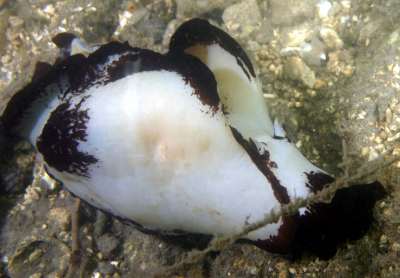
Thanks for your help. This Sea Hare was found in about three feet of water just east of the Blue Heron Blvd Bridge in Riviera Beach, Florida. Basically it was about 10 feet from shore, about 6-8 inches long, and about 3 inches in diameter.
Locality: Riviera Beach, Florida, USA. Atlantic Ocean. Depth: 3 feet. Length: 8 inches. 15 April 2005. rocky, muddy bottom near bridge pilings. Photographer: Douglas Ebersole
It was swimming slowly on the bottom in and amongst the debris in the shallows. It is similar in size and shape to an Atlantic Black Seahare (Aplysia morio) but the coloration is different.
Douglas Ebersole
debersole@pol.net
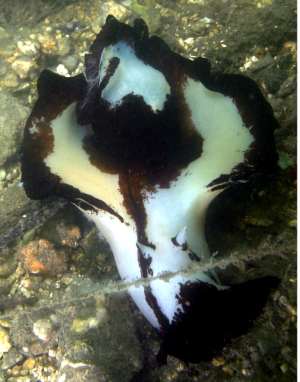
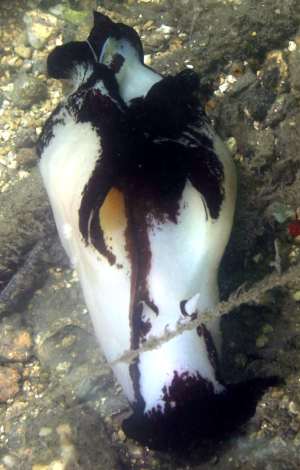
Dear Doug,
I don't know of any Sea Hare with this colouration. What I suspect is that it is an animal near the end of its life in which the outer layers of its skin are beginning to rub off. I have certainly seen 'geriatric' sea hares with much of the pigment layers of the skin rubbed off, and yet the animal was stilable to crawl. contract and swim - if rather slowly. If this is what is happening here, I must say that it is losing its colour layers in a very symmetrical way, but it's either that, or else you have a strange colour form of either Aplysia morio or perhaps A. brasiliana.
Best wishes,
Bill Rudman
Sea Hares from Florida
March 16, 2005
From: Stephanie
Hello,
Today while walking on the beach in Miami, Florida, I came across a large number of what appeared to be somekind of gelatinous creatures. It appeared as though they were beaching themselves and dieing in this particular area. They were very dark in color, and were releasing some type of purple ink. I tried putting several back into the water in hopes that they would continue living, but no luck. What are they, and what forced so many to beach wash upon the shore? Don't have any pics, but they looked like giant slugs, and the "ink" they were excreting was very strong, as the color remained vivid in the water for quite some time. The area was a boat marina off of Brickell Blvd. Length: approx 10" in diameter/varied. 14 March 05
Poor creatures! No one seemed to know what they were.
Thank you,
Stephanie.
saldanasa@hotmail.com
Stephanie, 2005 (Mar 16) Sea Hares from Florida. [Message in] Sea Slug Forum. Australian Museum, Sydney. Available from http://www.seaslugforum.net/find/13340Dear Stephanie,
Sounds like you found some Sea Hares. They often wash up in large numbers like this and they produce a purple ink. See the page on mass mortality. The two species you are most likely to find in Florida are Aplysia brasiliana and Aplysia morio. Have a look at the Fact Sheets for those species and some of the associated messages.
Best wishes,
Bill Rudman
Re: Aplysia morio from Miami, Florida
December 24, 2004
From: Robert Rio
Hi.
Thanks for maintaining this page. I saw one of these critters two weeks ago [1 August 2004] and I'd been going crazy trying to figure out what it was. It was on the beach at Hutchinson Island, Florida, where I was surf fishing with my dad. It was swimming very weakly in about two feet of water and appeared ill. I am born and raised in Florida and have spent thousands of hours fishing and diving, and never seen one of these critters before. I didn't have a camera handy, but it was definitely this animal.
Robert Rio
RRio415235@msn.com
Rio, R., 2004 (Dec 24) Re: Aplysia morio from Miami, Florida. [Message in] Sea Slug Forum. Australian Museum, Sydney. Available from http://www.seaslugforum.net/find/12741Aplysia morio from Miami, Florida
March 17, 2004
From: Boriana Slabakova
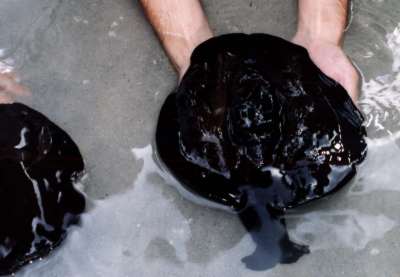
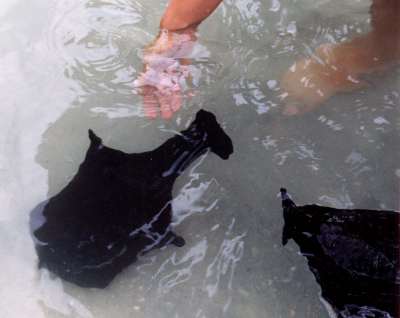
I am taking Marine Biology at school and we go to different locations to observe specimens and learn about them. We found two seaslugs on the shore of the beach, and later one more pinned on the rocks [Miami, Florida, USA]. I don't know much at all about the sea slug, in fact, that was the first time I saw it. I just want to know if its natural for them to be in an area where the river meets the salt water (not even the ocean, but the bay), if you want I can give you a map of where I found them. Also, what type of food do they eat and what parts of the world are they found in. Thank you so much, this will help my school report a bunch!
Thanks
Boriana Slabakova
boriana84@yahoo.com
Slabakova, B., 2004 (Mar 17) Aplysia morio from Miami, Florida. [Message in] Sea Slug Forum. Australian Museum, Sydney. Available from http://www.seaslugforum.net/find/12465Dear Boriana,
This is a Sea Hare called Aplysia morio which is known from Bermuda and the eastern USA from Rhode Island to Florida and Texas. If you look at other messages on this page you will see it is a swimmer, and is quite commonly found in Florida. Another species, Aplysia brasiliana, is also quite common in Florida. There are many species of Sea Hares, some are very widespread around the world, while others, like A. morio, seem to have much smaller geographic ranges. All Sea Hares eat algae, although most prefer just a few species or red and green algae.
For more information on Sea Hares go to the Sea Hare Fact Sheet which has links to other pages with more information. Also, have a look at the earlier messages on this page.
Good luck with your report
Bill Rudman
Black Sea Hare from Florida
March 9, 2004
From: Gene Browning
We have sighted 2 black sea hares in 2 days (or the same one twice). We pulled it from the water by the Fisher Island slip (south side of Fisher Island, Biscayne Bay. Florida [USA]) at lunchtime today. It spewed an inky substance at us when it came up in the net and again upon release.
This hare had large wings (about 14" across) and no markings. First one any of us had seen with 70 years at sea between the 3 of us.
Gene Browning
genebrowning@cfl.rr.com
Browning, G., 2004 (Mar 9) Black Sea Hare from Florida. [Message in] Sea Slug Forum. Australian Museum, Sydney. Available from http://www.seaslugforum.net/find/12399Dear Gene,
This is probably the Sea Hare Aplysia morio. See my comments on Nick Boyd's photo and recent message [#12308].
Best wishes
Bill Rudman
Swimming Aplysia in Florida
February 25, 2004
From: J. Nicholas Boyd
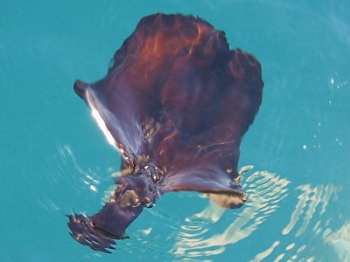
Dear Bill,
I took this photo from boat off Pompano Beach [Southeast coast of Florida, USA, Atlantic Ocean coast]. It was close to shore swimming on surface like a ray but it was not a ray - it was about 1 foot across
can you help identify
J. Nicholas Boyd (Nick)
Boca Raton, Florida
nboyd@oceanlandinc.com
Boyd, J.N., 2004 (Feb 25) Swimming Aplysia in Florida. [Message in] Sea Slug Forum. Australian Museum, Sydney. Available from http://www.seaslugforum.net/find/12308Dear Nick,
This is a Sea Hare, most probably Aplysia morio which is often found swimming in your part of the world. Another possibility is Aplysia brasiliana which is also a common swimmer in the Caribbean, but that has a much more mottled colour. Have a look at some of the earlier mesages, and the Fact Sheets I have linked to for information on these animals and their swimming behaviour.
Best wishes
Bill Rudman
Mystery slug found in Trinidad
May 13, 2003
From: Danielle

A small purplish black sea slug was found on the north coast of Trinidad (in the Caribbean). The authorities can't identify it, and it's the first time it has appeared here.... about 5 have been found in the past week. I found one today... it's about the size of a fist, curled up in a ball, but when in water it unfurls and has 'winglike' fins like a small sting ray. Its underside is like a snail's, and its mouth is like a suction thingy. Its body seems muscular and it contracts and pulses and so on. It is said to secrete a purple substance. With its mouth and head (or so it seems) it clings to the side and corners of the aquarium, and keeps its head above water. I would appreciate assistance in identifying this species. Enclosed is the article.
Danielle
cool_likeafridge@msn.com
Dear Danielle
A swimming black slug, with winglike fins and producing purple ink, can only be a slug we call a Sea Hare. The species is probably Aplysia morio although there is another swimming species in the Caribbean, Aplysia brasiliana, but that is usually a browner colour. Have a look at the other messages below yours on the A. morio from more information on this species. Also have a look at the Sea Hares Page for more information on these animals. Many of them produce the Purple Ink you describe. They usually produce it when they are stressed, but we have no idea what it is for.
Best wishes,
Bill Rudman
Aplysia morio in Florida
July 27, 2002
From: Joe Hauth
Bill,
Just returned from a beach vacation in Perdido Key, Florida (just west of Pensacola). While on a night time hunt through tidal pools with my 2 young boys (7 & 5 yo), we came upon quite a few animals we had never seen before. After looking through your web site, now we are sure they were Aplysia morio. One was approximately 20cm, most were 7-10 cm. While running on the beach the following morning I saw 50-60 that had washed up on the shore.
Just wanted to let you know that we enjoyed your web site and had a fun educational experience searching through it - myself and the kids. PS - haven't developed images yet.
Thanks,
Joe Hauth MD
New Orleans, La.
jwhmdmba@yahoo.com
Hauth, J., 2002 (Jul 27) Aplysia morio in Florida. [Message in] Sea Slug Forum. Australian Museum, Sydney. Available from http://www.seaslugforum.net/find/7652Dear Joe,
Thanks for the feed back. Photos are always welcome
best wishes,
Bill Rudman
Re: Sea slugs washed up in Florida
May 30, 2002
From: Marion Reamer
Thank you for your reply. I read all the pertinent information from other people and these are sea hares definitely. They are dark brown to black. Very interesting site. Thanks again for all the interesting letters.
Marion Reamer
marionreamer@adelphia.net
Reamer, M, 2002 (May 30) Re: Sea slugs washed up in Florida. [Message in] Sea Slug Forum. Australian Museum, Sydney. Available from http://www.seaslugforum.net/find/7090Dear Marion,
From your colour description I would say your animals are probably Aplysia morio.
Bill Rudman
Sea slugs washed up in Florida
May 29, 2002
From: Marion Reamer
We live on Hutchinson Island, Florida and we have never seen these on the beach before. Can you tell us anything about why they would be here all of a sudden, being washed up on the beach.
Thanks for any info.
Marion Reamer
marionreamer@adelphia.net
Reamer, M., 2002 (May 29) Sea slugs washed up in Florida. [Message in] Sea Slug Forum. Australian Museum, Sydney. Available from http://www.seaslugforum.net/find/7079Dear Marion,
Unless I have some description or illustration it's a bit hard to know what you are asking about. One possibility are Sea Hares. Have a look at the messages on Aplysia brasiliana and Aplysia morio which are two slugs which wash up in Florida quite regularly. I discuss reasons why they 'washup' in my replies to messages on those pages.
Best wishes,
Bill Rudman
Sea Hare from Mexico
February 9, 2002
From: George & Mila
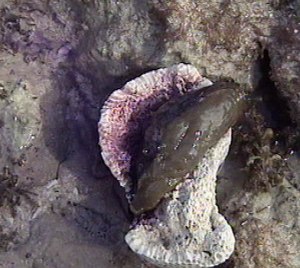
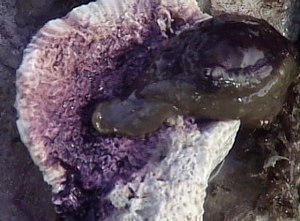
Dear Dr. Rudman,
Few weeks ago I sent you a question about creature we've seen in Cancun, Mexico. You were very kind to answer my question. Now I'd like to send you some photos. These are from video camera and resolution is not so good but any way... Here they are:
As you could see the creature was sliding under the coral pouring ink all the time.
Thank you
George & Mila.
GKaskanlian@webtv.net
Kaskanlian, G. & M., 2002 (Feb 9) Sea Hare from Mexico. [Message in] Sea Slug Forum. Australian Museum, Sydney. Available from http://www.seaslugforum.net/find/6119Dear George & Mila,
Thanks for the photos. Yes it is a sea hare and most probably Aplysia morio. Sea Hares don't normally continually to 'ink' as they crawl along so it is possible this animal had been injured in some way.
Best wishes,
Bill Rudman
Mystery from Mexico
January 17, 2002
From: George & Mila
Hello,
We've been on vacation close to Cancun. In tide pools we've seen dark green slug about 4 inches long that looked like a nudibranch. When I've touched it, it started to pour in the water violet ink. Can you, please, tell me what it was?
Thanks.
George & Mila
GKaskanlian@webtv.net
George & Mila, 2002 (Jan 17) Mystery from Mexico. [Message in] Sea Slug Forum. Australian Museum, Sydney. Available from http://www.seaslugforum.net/find/6011Dear George & Mila,
I guess the Cancun you are talking about is on the Yucatan Peninsula, Mexico? From the purple ink I guess the animal you saw was a Sea Hare, most of which produce a red or purple ink when disturbed. Have a look at the Sea Hare Page and the Sea Hares Defence Page for further information.
Best wishes,
Bill Rudman
Re: Sea Hares from Florida
July 13, 2001
From: Bill Mueller
Dr. Rudman,
Thanks for taking the time to write me back. It appears, from the other queries, that this unknown little guy has been making appearances all over the place!
Thanks again,
Bill Mueller
calripkin8@yahoo.com
Mueller, W. , 2001 (Jul 13) Re: Sea Hares from Florida. [Message in] Sea Slug Forum. Australian Museum, Sydney. Available from http://www.seaslugforum.net/find/4807Sea Hare - Aplysia morio in Florida
July 4, 2001
From: Sandy Iamartino
Just wanted to let you know that my children and I found many of the black sea hares - Aplysia morio - washing up on shore on Huntington Island, Florida on June 28 and 29, 2001. The weather had been rainy and windy. The ocean was a bit rough but not excessively so. We were able to identify them through your website. The information that you gave was very interesting. I have lived in Florida over 30 years and had never seen anything like them. They made the trip to the beach very educational.
Sandy Iamartino
siamartino@AOL.COM
Iamartino, S., 2001 (Jul 4) Sea Hare - Aplysia morio in Florida. [Message in] Sea Slug Forum. Australian Museum, Sydney. Available from http://www.seaslugforum.net/find/4719Gulf Coast of Florida find
June 29, 2001
From: Bill Mueller
I was in Panama City Beach, Florida [USA] and saw what I believe is a nudibranch. It was black/purple and emitted a pink to purple dye when approached. It had a snail-like head and swam with wings at or near the surface. We were at the jetty cut where St. Andrew's bay empties into the Gulf of Mexico. The water was clear, 6 ft. deep, with a sandy bottom.
Any ideas as to it's name? I looked through the Panamerican species and didn't see it. I got a picture that has not been developed yet but upon looking at the intructions for the underwater disposable, it said the subject had to be 3 feet away and I was much closer, so I wonder if it will turn out?
Thanks for any help you can provide,
Bill Mueller
Tallahassee, Florida.
CalRipkin8@yahoo.com
Mueller, W., 2001 (Jun 29) Gulf Coast of Florida find. [Message in] Sea Slug Forum. Australian Museum, Sydney. Available from http://www.seaslugforum.net/find/4683Dear Bill,
Your animal is a Sea Hare, some species of which can swim, and most produce the purple ink you describe. From the many messages to the Forum over the last few years it seems there are two common swimming species found in your region, Aplysia brasiliana and Aplysia morio. The dark brown-black one is A. morio.
If you want to know more about these animals have a look around the Forum at the information pages and the earlier messages. Use the navigation buttons in the bar at the top and bottom of each page or just click on anything that's underlined.
best wishes,
Bill Rudman.
Sea hare from Florida
May 14, 2001
From: Marjorie Pardun
Hello,
The other day, May 6, on the beach in Jupiter Island, Florida we were walking and we found washed up on the shore a species of something I have never seen before. I am an avid and frequent beachcomber. The creature was dark brown to black it was oval shaped it looked as though it had horns, somewhat like a slug, hence I typed in sea slug for my search, it had a wavy area which spread horizontally across its body and moved in a waving motion. It seemed harmless since we threw many back into the surf. However, once we noticed a purple color exudate from it, which washed off easily. I wonder if you could tell me what it may be?
Marjorie Pardun
MarGeo27@earthlink.net
Pardun, M, 2001 (May 14) Sea hare from Florida. [Message in] Sea Slug Forum. Australian Museum, Sydney. Available from http://www.seaslugforum.net/find/4315Dear Marjorie,
Your animal was a Sea Hare, and almost certainly a species called Aplysia morio. The purple ink is ver characteristic of sea hares and as you will if you look above and below your message, this species is quite common in Florida.
To find more general information just click on any underlined word and it will take you to a relevant page. There are quite a few links to other pages on the Sea Hares page. Best wishes,
Bill Rudman
Aplysia morio from Florida
May 9, 2001
From: Kay Warren
While walking in the ocean off Key West, Florida, we came upon this creature that resembled a snail without a shell. It was dark brown and when I tried to pick it up with a board, it released a red fluid type substance. I managed to get in up on the board so I could get a closer look at it. It had something like a ruffley skirt type thing around the whole bottom and the horns like a snail or slug. I released it back and then found even more of them. The water was only about 2 feet deep, it was February of 2000. Was I looking at a sea slug?
Thank you!
Kay Warren
kwarren@lcp2.net
Warren, K., 2001 (May 9) Aplysia morio from Florida. [Message in] Sea Slug Forum. Australian Museum, Sydney. Available from http://www.seaslugforum.net/find/4286Dear Kay,
Yes your animal was a sea slug called a Sea Hare and was almost certainly a species called Aplysia morio which is found in Florida. Have a look at the page on Aplysia brasiliana which is also found in Florida. The red fluid you mention is exuded by many Sea Hares when stressed, but we don't really understand its true function.
I am not sure if you are familiar with the Forum, but if you click on any of the underlined words you will go to a relevant page. On each 'page' there is an introductory section and below that are relevant messages arranged chronologically. It's worth having a look through these messages because there is usually a lot more information there.
Best wishes,
Bill Rudman
Photos of Florida Sea Hares
March 9, 2001
From: Anne DuPont

Dear Bill,
Since there have been several letters regarding Sea Hares from Pompano Beach, Florida, I wanted to see them, so I walked the beach several days but did not see them. They are, however, now in the canals and I found this one under a dock at a friend's house in Pompano Beach.
I put it in a white bucket and photographed it, and also had a friend photograph it in my hand. It did NOT ink me at all. It was swimming with it's head out of the water a lot. Can you identify it for me from these photos?
Thank you for all the work you do on the forum.
Best Regards,
Anne DuPont
Delray Beach, Fl. USA
adupont@gate.net

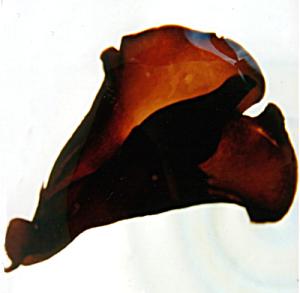
Dear Anne,
Thanks for the photos. From my understanding of the Aplysia species in your area [ which is not great] the two common species are Aplysia dactylomela and A. brasiliana which ranges in colour from dark brown, as in your photos, to light mottled brown, as in the earlier photos you sent, some of which are at the top of the page.
If you have a look at Betsy's earlier message you will see a photo of a very similarly coloured swimming animal.
Unfortunately Sea Hares are not a good size for photography - usually just too big for a macro lens, and definitely too large for most photographic trays or dishes. I must say I have ended up using buckets in the past. Thanks for going to the trouble of taking these photos,
Best wishes,
Bill Rudman
Note added March 9, 2001: This is A. morio not A. brasiliana. See message. A. morio is an uniform dark brown or black while A. brasiliana has a mottled colour pattern of dark and light brown.
Rudman, W.B., 2001 (Mar 9). Comment on Photos of Florida Sea Hares by Anne DuPont. [Message in] Sea Slug Forum. Australian Museum, Sydney. Available from http://www.seaslugforum.net/find/3944Dying Sea Hares are Aplysia morio
March 9, 2001
From: Michael C. Schmale
Dear Bill,
Anne DuPont has sent me copies of her Aplysia photos from Pompano Beach, Florida. Based on these photos, I believe this is the relatively uncommon Black Sea Hare, Aplysia morio. I checked on the Sea Slug Forum and saw that this species was not listed. We do not see it very often here in Miami but it is an interesting one as it can get very large (over one foot long). It is characterized by black or very dark brown skin with little or no marking. Also, according to Voss's reference on sea shore life, the parapodia (wings) are relatively large. Betsy's photos [April 27, 2000], also appear to be of A. morio as well.
In case you were not aware, we have a large hatchery for Aplysia here at the University of Miami marine lab. We culture Aplysia californica throughout the life cycle and provide animals of all ages and sizes to neuroscience researchers around the world these animals are very useful due to their simple nervous system and large nerve cells). On average, we ship out about 15,000 animals per year with support from the National Institutes of Health.
Another Aplysia fun fact is that one of the recipients of the Nobel prize in Physiology and Medicine this year was given this award based on his research on memory and learning using the Aplysia (A. californica). So, you could say that Aplysia won this year's Nobel prize.
All the best,
Mike Schmale
Michael C. Schmale, PhD
Associate Professor
Division of Marine Biology and Fisheries
Rosenstiel School of Marine and Atmospheric Science
University of Miami
4600 Rickenbacker Cswy.
Miami, FL 33149
mschmale@rsmas.miami.edu
Schmale, M.C., 2001 (Mar 9) Dying Sea Hares are Aplysia morio. [Message in] Sea Slug Forum. Australian Museum, Sydney. Available from http://www.seaslugforum.net/find/3953Dear Michael,
Thanks for sorting out this identification problem - and thanks Anne for finding some local knowledge which is very welcome. I have moved Annne and Betsy's photos to a new Aplysia morio page. I guess that most of the the recent mass mortality reports from Florida probably involve Bursatella, and A. morio, rather than A. brasiliana, so I'll move them over as well.
Erik Kandel's Nobel Prize and your amazing Aplysia breeding facility are indeed known to Forum visitors.
Thanks again for your help,
Bill Rudman
More Sea Hares in Florida
March 4, 2001
From: Jackie O'Neal
Brown blobby thing washed up on shore at Pompano Beach, Florida, USA. E-mailed Steve Long. Said it may be Aplysia dactylomela. Pulled up on computer and got into your site somehow. Looks like Aplysia vaccaria, close to Aplysia fasciata, and Aplysia californica. Has wings almost. Very curious to know what it is. Never saw anything like it before. I am absolutely amazed after pulling up seaslug.com that there are so many slugs living in the sea. I am curious as to why they washed up on our shore at all. There was quite a lot of seaweed about. This was a couple of days ago around Feb 26th. Today March 1st, there were still a few in the ocean. Not so many washed up on the shore, which cut my trip in half as I didn't have to throw them back in the water. The wind or at least the tide seemed to be coming out of the south east today. There were no markings on the slugs at all. Just very dark brown. Two of them did omit a purplish red substance which I thought was blood and that I had hurt them. According to Steve that is a defense mechanism that they use. Would appreciate any information you can give me.
Yours sincerely,
Jackie O'Neal
Pompano Beach, Florida, USA.
0411@mediaone.net
O'Neal, J., 2001 (Mar 4) More Sea Hares in Florida. [Message in] Sea Slug Forum. Australian Museum, Sydney. Available from http://www.seaslugforum.net/find/3902Dear Jackie,
In the last couple of weeks there seems to have been 'aggregations' of at least two species of Sea Hares. Have a look at the recent messages from Talia and Krystal reporting Aplysia brasiliana from Florida, and Dana with photos of Bursatella leachi.
I am not sure how familiar you are with websites, but if you click on any underlined word you will be taken to another relevant page. If you look at the references mentioned in my comments to the above messages, and look at other messages on the same pages, you should get some background information on why we sometimes find large numbers of Sea Hares like this.
Concerning Purple Ink. There is no evidence to show that it has any defensive function in any species of Sea Hare, but we have no idea what other function it might have. Perhaps it is just an excretory product.
I am pretty sure your animal is Aplysia brasiliana.
Best wishes,
Bill Rudman
Note added March 9, 2001: This is A. morio not A. brasiliana. See message. A. morio is an uniform dark brown or black while A. brasiliana has a mottled colour pattern of dark and light brown.
Rudman, W.B., 2001 (Mar 4). Comment on More Sea Hares in Florida by Jackie O'Neal. [Message in] Sea Slug Forum. Australian Museum, Sydney. Available from http://www.seaslugforum.net/find/3902And more Aplysia from Florida
March 4, 2001
From: Dawn A.
We found 5 Sea hares close to the shore (and some even washing up) on Pompano Beach [Florida] today. All of the sea hares were about 6-8 inches in diameter. How can you tell a male from a female? We handled the sea hares, not really knowing if it was safe, but we wanted to get them back in the water from the sure, as not to dry out in the hot sun. Is there any part of handling the animal dangerous to humans? One did secrete the purple/pink dye...freaked me out, but didn't seem to harm me.
Great site!!
Dawn.
Hamsterchickster@cs.com
Dawn A., 2001 (Mar 4) And more Aplysia from Florida. [Message in] Sea Slug Forum. Australian Museum, Sydney. Available from http://www.seaslugforum.net/find/3903Dear Dawn,
Sea Hares have definitely been making their presence felt in Florida. Have a look at Jackie's message, also from Pompano Beach, which I have posted today for some background information on Sea Hares and why they are sometimes found in large numbers. I am pretty sure your animal is Aplysia brasiliana.
About your specific questions. No Sea Hares can't harm you and the purple ink is harmless. Have a look at the Sea Hares Page for some general information. If you are not familiar with web pages - click on any underlined word and you will be taken to a relevant page. On telling males from females, all sea slugs are hermaphrodites. That is they are fully functional males and females. If you are interested there is a photo of a group of them on the Sea Hares mating page.
Best wishes,
Bill Rudman
Note added March 9, 2001: This is A. morio not A. brasiliana. See message. A. morio is an uniform dark brown or black while A. brasiliana has a mottled colour pattern of dark and light brown.
Rudman, W.B., 2001 (Mar 4). Comment on And more Aplysia from Florida by Dawn A.. [Message in] Sea Slug Forum. Australian Museum, Sydney. Available from http://www.seaslugforum.net/find/3903Re: Sea Hares in Florida
March 3, 2001
From: Krystal
Dear Bill,
Sorry, but I couldn't get you a picture of my slugs. I went back to the beach the next day and
they were gone :(
They were dark brown, almost black, like the photos of Aplysia brasiliana on the Forum, but the
little one in my fish tank is a lighter brown. They were smooth, not hairy like the ones in Dana's photos.
Krystal
Skavolley@aol.com
Krystal , 2001 (Mar 3) Re: Sea Hares in Florida. [Message in] Sea Slug Forum. Australian Museum, Sydney. Available from http://www.seaslugforum.net/find/3901Dear Krystal,
Thanks for trying. Often these mass 'swarming' events only last a couple of days or so. From your description I am sure you had Aplysia brasiliana rather than Bursatella leachi which Dana found.
And why did both species do this at the same time? I guess they both have a similar breeding cycle which would have produced a buildup of breeding adults at the same time. Probably the same environmental conditions, spring tides, high temperature and/or inshore winds for example resulted in large numbers being washed up on the beaches.
Best wishes,
Bill Rudman
Note added March 9, 2001: This is A. morio not A. brasiliana. See message. A. morio is an uniform dark brown or black while A. brasiliana has a mottled colour pattern of dark and light brown.
Rudman, W.B., 2001 (Mar 3). Comment on Re: Sea Hares in Florida by Krystal . [Message in] Sea Slug Forum. Australian Museum, Sydney. Available from http://www.seaslugforum.net/find/3901Sea Hares in Florida (2)
February 27, 2001
From: Krystal
Hello,
I am often in the ocean. However, today when I visited the beach, for the first time I found these jellyfish-like cratures washing up on the shore. I live on the east coast of south Forida. After closer observation I came to the conclusion that the animals were in fact sea slugs. They varied in size and were dark brown. When I picked one up it shot out purple die or ink on my hand. Also they had sort of wings with which they swam with, and looking closer I noticed two pin dot eyes and the bottom was like that of a snail or slug. I have never seen one like this here before and i was wondering if you can confirm my observation.
Thanks.
Krystal
Hello, again I've looked through your species list and found that the sea slug or sea hare that i found today was in fact the aplysia brasiliana. I found that perhaps the many hares that were washing ashore were old and dying, but i saved two small ones( who may be old also) and placed them in my saltwater fish tank. If you'd like to know I can keep you updated on there life. I enjoyed you infomative website on sea slugs keep up the good work!
Krystal
skavolley@aol.com
Krystal, 2001 (Feb 27) Sea Hares in Florida (2). [Message in] Sea Slug Forum. Australian Museum, Sydney. Available from http://www.seaslugforum.net/find/3870Dear Krystal,
I have put both your messages together. I had just finished a reply to your first message suggesting it was Aplysia brasiliana when your second message arrived confirmimg my identification. Glad to be of help. It would certainly be interesting to hear what your two small animals do in the aquarium. I see from Dana's message and Talia's message that you seem to be having a 'Mass mortality event' in Florida at the moment.
Best wishes,
Bill Rudman
Note added March 9, 2001: This is A. morio not A. brasiliana. See message. A. morio is an uniform dark brown or black while A. brasiliana has a mottled colour pattern of dark and light brown.
Rudman, W.B., 2001 (Feb 27). Comment on Sea Hares in Florida (2) by Krystal. [Message in] Sea Slug Forum. Australian Museum, Sydney. Available from http://www.seaslugforum.net/find/3870Sea Hares in Florida (3)
February 27, 2001
From: Talia Williams
Just wondering if anybody can help me out. I live in South Florida. I was at the beach the other day when I saw Sea Hares for the first time. I was curious as to why they are there. There was tons of seaweed on the beach as well as the sea hares. Is it mating season or did they just come in with the weeds? Please let me know and if you know any sites where I can get more info that would be great.
Talia Williams
Talia1122@aol.com
Williams, T., 2001 (Feb 27) Sea Hares in Florida (3). [Message in] Sea Slug Forum. Australian Museum, Sydney. Available from http://www.seaslugforum.net/find/3873Dear Talia,
If you have a look at the other two messages I have just got from south Florida [Dana's & Krystal's] it seems there are a lot of Sea Hares washing up and dying at the moment. The species of Sea Hare is probably Aplysia brasiliana and what you have seen is described on a page on the Forum I have called the Mass Mortality Page. Have a look at that page and other messages below yours on this page - if by chance you are unfamiliar with the way webpages work, if you click on any underlined word you will be taken to another relevant page. If you have time to read all the pages on the Forum dealing with Sea Hares I think you'll be doing well.
Best wishes,
Bill Rudman
Note added March 9, 2001: This is A. morio not A. brasiliana. See message. A. morio is an uniform dark brown or black while A. brasiliana has a mottled colour pattern of dark and light brown.
Rudman, W.B., 2001 (Feb 27). Comment on Sea Hares in Florida (3) by Talia Williams. [Message in] Sea Slug Forum. Australian Museum, Sydney. Available from http://www.seaslugforum.net/find/3873Florida Keys - Sea Hare Sighting
April 27, 2000
From: Betsy
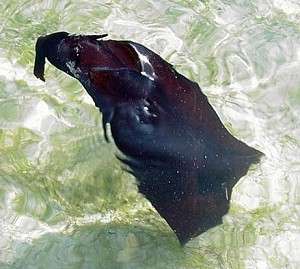
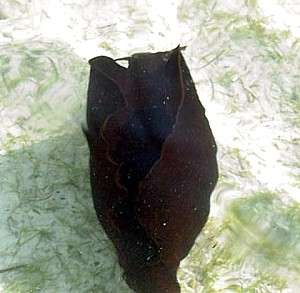
On Easter Sunday, at Islamorada, Florida Keys, we found ourselves reviving a blob of pulsating matter on the beach left by an ebbing tide as sunrise service broadcast messages of resurrection down the breeze. We've now learned we saved a Sea Hare which did not feel the need to spray us with ink....or had none left to spray after drying out for about an hour or two before we noticed its last sparse pulses and returned it to the sea. It took about an hour for it to take on fluids and return to a recognizable shape, almost manta ray like...and it was swimming in an undulating, almost sea turtle like pattern rising to the surface every few strokes. Then it settled down to a grassy patch to process seaweed, sand and small shells through its rubbery cocoa colored body pumping excesses out with water behind it as it ate.
Thought you'd like to see a few pictures of our Easter sea creature, so aptly named "hare" !
Betsy
bb66666666@aol.com
Betsy, 2000 (Apr 27) Florida Keys - Sea Hare Sighting. [Message in] Sea Slug Forum. Australian Museum, Sydney. Available from http://www.seaslugforum.net/find/2319Dear Betsy,
It's not every day you can save the Easter Bunny!
I guess your Sea Hare is Aplysia brasiliana which you will see from the messages below yours on this page is quite a well-known swimmer in Florida. I'm afraid that Sea Hares are not good at saving themselves when they get stranded as the tide recedes. If you are interested in knowing more about these animals have a look at the Sea Hare Page.
Thanks for the photos of it swimming.
Best wishes,
Bill Rudman.
Note added March 9, 2001: This is A. morio not A. brasiliana. See message. A. morio is an uniform dark brown or black while A. brasiliana has a mottled colour pattern of dark and light brown.
Rudman, W.B., 2000 (Apr 27). Comment on Florida Keys - Sea Hare Sighting by Betsy. [Message in] Sea Slug Forum. Australian Museum, Sydney. Available from http://www.seaslugforum.net/find/2319Black swimming sea slug So. Florida.
May 12, 1999
From: Kathy Dougherty
I'am trying to I.D. a sea slug found swimming in the intercoastal waterway in 5 to 15 fT. of water. It has enlarged winglike parapodia and kept raising it head out of the water as it swam. Another one was seen clinging to a sea wall , it is black with no markings and about 5 inches long. I dive in the ocean here and have never seen these. Would love to know more ?
Kathy Dougherty
CashmStd@aol.com
Dougherty, K., 1999 (May 12) Black swimming sea slug So. Florida.. [Message in] Sea Slug Forum. Australian Museum, Sydney. Available from http://www.seaslugforum.net/find/855Dear Kathy,
It sounds like a Sea Hare. Have a look at my answer to Esat Atikken's message also about a swimming slug from Florida. Also have a look at my answer to another message today about a 'brown' swimming slug from Florida which I guess is the same. It looks like Florida is a popular spot for Sea Hares at the moment.
Any chance of a photo to put on the Forum?
Best wishes,
Bill Rudman
